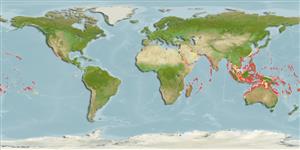Common names from other countries
>
Gobiiformes (Gobies) >
Gobiidae (Gobies) > Gobiinae
Etymology: Callogobius: Greek, kalos, kallos = beautiful + Latin, gobius = gudgeon (Ref. 45335).
More on author: Steindachner.
Environment: milieu / climate zone / depth range / distribution range
Ecologia
marinhas associadas(os) a recifes; intervalo de profundidade 1 - 37 m (Ref. 86942). Tropical; 32°N - 28°S
Indo-Pacific: Red Sea and western Indian Ocean to tropical western Pacific from southern Japan and Ogasawara Ids, south to Australia, Queensland, New Caledonia and Tonga.
Tamanho / Peso / Idade
Maturity: Lm ? range ? - ? cm
Max length : 7.0 cm TL macho/indeterminado; (Ref. 11344)
Descrição suscinta
Chaves de identificação | Morfologia | Morfometria
Espinhos dorsais (total) : 7; Raios dorsais (total) : 9; Espinhos anais: 1; Raios anais : 7. Dark bar from eye to upper lip, vertical bar under eye, broad dark band from eye to opercle; vertical bar under first dorsal fin; caudal fin with wavy dark stripes (Ref. 2798); characterized further by pale brown to whitish body color; variably joined pelvic fins at median from base to about two-thirds length of fifth ray; pelvic frenum absent; very long and pointed caudal fin; longitudinal scale series 63-67; cycloid scales on head and anterior body; becoming ctenoid posteriorly; cycloid scales on cheek and opercle; predorsal scales 11, extending to interorbital space; head with prominent papillae ridges; depth of body 4.7-5.5 in SL (Ref. 90102).
Found in crevices and caves (Ref. 2334, 9360), usually under loose debris (Ref. 48637).
Ciclo de vida ou comportamento de acasalamento
Maturities | Reprodução | Spawnings | Egg(s) | Fecundities | Larvas
Myers, R.F., 1991. Micronesian reef fishes. Second Ed. Coral Graphics, Barrigada, Guam. 298 p. (Ref. 1602)
Status na Lista Vermelha da UICN (Ref. 130435)
CITES (Ref. 128078)
Not Evaluated
Ameaça para os humanos
Harmless
Uso pelos humanos
Ferramentas
Relatórios especiais
Baixar XML
Fontes da internet
Estimates based on models
Preferred temperature (Ref.
115969): 24.7 - 28.9, mean 27.6 (based on 608 cells).
Índice de diversidade filogenética (Ref.
82804): PD
50 = 0.5000 [Uniqueness, from 0.5 = low to 2.0 = high].
Bayesian length-weight: a=0.00708 (0.00333 - 0.01504), b=3.09 (2.92 - 3.26), in cm Total Length, based on LWR estimates for this (Sub)family-body shape (Ref.
93245).
Nível Trófico (Ref.
69278): 3.2 ±0.3 se; based on size and trophs of closest relatives
Resiliência (Ref.
120179): Elevada, tempo mínimo de duplicação da população menor que 15 meses (Preliminary K or Fecundity.).
Fishing Vulnerability (Ref.
59153): Low vulnerability (10 of 100).
